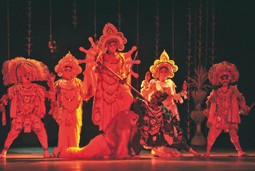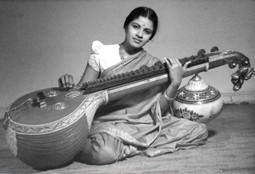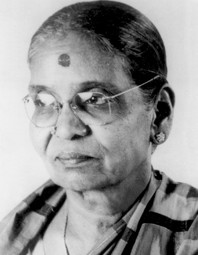COVER STORY - The mysterious and exciting world of Chhau by S. JANAKI

A burst of music and reverberating drums heralds the beginning of a Chhau performance. A large group of traditional musicians accompanies the presentation of Seraikella, Mayurbhanj and Purulia Chhau. The nearly 30-strong contingent of dancers and musicians headed by Shashadhar Acharya comprises three sets of dancers and musicians each. The presentation is intelligently planned to showcase all three Chhau styles to the uninitiated Chennai audience at the Sruti Foundation’s celebration.
The instrumental offering by all the Chhau musicians – known as the Jatra Ghat in Seraikella, Rang Baja in Mayurbhanj and Judan in Purulia – with its catchy tunes and frenzied play of percussion seeks to evoke the blessings of the patron deities and infuse the dancers with divine inspiration.
The Chhau movements are dynamic, with amazing control over breath, body movements and energy release. It is an intriguing world of masks and movements. Each Chhau style is distinct. As you watch the items you can savour the flavour of eastern India – the earthy fragrance of Jharkhand (Seraikella), Bengal (Purulia) and Odisha (Mayurbhanj). All three styles are performed by men who don the female roles too. Of late, we are told, women have been learning and performing Chhau.
SPECIAL FEATURE - Guru-s and mentors by GOWRI RAMNARAYAN

(M.S. Subbulakshmi’s death anniversary falls on 11 December)
Semmangudi Srinivasa Iyer had heard Subbulakshmi in her early teens, with her mother playing the veena, Sankara Narayana Iyer on the violin, and brother Saktivel on the mridangam. He deemed her an artist of dignity, knowledgeable in theoretical aspects of music, a sastragnai.
Semmangudi became a close friend of Sadasivam, who in time asked him to teach MS. Innum azhuttham kondu varanum, (You must instil more profundity), he said. Semmangudi found in MS an ekachandagrahi, someone who got everything right the first time. He noted several special qualities about her voice. It was not just pleasing and pitch perfect, but had a reenkaram or reverberation, sounding the same up close and at a distance; it was not distorted or weakened when you heard it from different directions. It had gatram or weight, and remarkable continuity. “When you strike a temple bell, the echo continues after the sound ends, until the next striking. Her voice has that quality. When she stops singing, the nadam continues.” He found her a gnanasti, one who had a discerning taste, intelligence, and a relish for the best, and therefore able to discard anything less than the cream. Remarkably, Edu sramamo adu avalukku sulabhama vandadu – saukhyam (She found effortlessly that which is difficult to find – tranquillity).
CENTENARY FEATURE - MY GURU by GEETHA RAJA

This is the centenary year of my guru T. Brinda – Brindamma to many of us – an illustrious member of the veena Dhanammal family, a veritable treasure house of Carnatic music.
Born in May 1868, Veena Dhanammal was the granddaughter of Kamakshamma, a renowned dancer in the Tanjore Court, who initiated her into music studies. Dhanammal also learnt from her mother Sundarammal, Sathanur Panchanada Iyer and Veena Baldas. Dharmapuri Subbaraya Iyer and Tiruvottriyur Tyagier were other musical stalwarts who enhanced Dhanammal’s perceptions.
Dhanammal’s career as a remarkable vainika spanned almost sixty years and during this time she carved a niche for herself in the annals of Carnatic music as the founder of a style known for its melody and tranquillity.
Successive generations carried on the precious family heritage of music and dance and thus we have many names dotting the genealogical tree: Rajalakshmi Ammal and Lakshmiratnam Ammal, Jayammal and Kamakshi Ammal (vocal); T. Sankaran (Tamil Isai School of Music); T. Brinda, T. Mukta and Vegavahini Vijayaraghavan (vocal), T. Abhiramasundari (violin); T. Balasaraswati and Lakshmi Knight (Bharatanatyam); T. Viswanathan (flute); T. Ranganathan (mridanga); T. Brinda’s grandson S. Girish (vocal), Balasaraswati’s grandson Aniruddha Knight (Bharatanatyam), T. Mukta’s granddaughter S. Uma Maheshwari (Bharatanatyam), and T. Brinda’s brother’s son Balaji Venkateswar (vocal) carry forward the legacy in the next generation.
NEWS & NOTES - SRUTI ENTERS 30th YEAR by LALITHA VENKAT
October 2012 is a significant month for Sruti, India’s premier magazine for the performing arts. Not only did it enter its 30th year on 16 October, the 80th birth anniversary of its late Founder-Editor falls on 24 October 2012. It was a double celebration from 19 to 21 October at the Bharatiya Vidya Bhavan, Chennai. It was a stormy day with heavy rain flooding the roads. The evening started with a short, well made 13-minute film on Sruti’s journey. It featured various Sruti covers, glimpses of significant articles, comments by K.V. Ramanathan, V. Ramnarayan, and S. Janaki, and testimonies by Aruna Sairam, the Dhananjayans, Gowri Ramnarayan, Amritha Murali and Rithvik Raja.
The film described how the first issue of Sruti was launched by Semmangudi Srinivasa Iyer in October 1983 with D.K. Pattammal on the cover and child prodigy Mandolin Shrinivas. Sruti was promoted as a not-for-profit venture and placed under a Trust in April 1985 when the Sruti Foundation was established with Founder-Editor N. Pattabhi Raman as its Managing Trustee. As far back as 1998, the Sruti website was launched by Semmangudi Srinivasa Iyer. When Pattabhi Raman passed away in 2002, the question uppermost on everyone’s mind was who would take on the leadership mantle. K.V. Ramanathan became the next Editor-in-Chief and the magazine got by the next four years till 2006, when The Sanmar Group took over Sruti and put it on a sound footing. The film had present Trustee of the Sruti Foundation Sukanya Sankar talking about the plans of the magazine. The main challenge now is to get younger readership and a step towards that is the online version and blog. Over the years the Sruti issues featured profiles of top musicians and dancers, the who’s who of the art world. Sruti’s horizon has expanded now and also features theatre work, contemporary Indian dance and articles on our heritage.


